By Chris Spangler
Nick Hamele jabbed a thin steel rod into glowing coals before pounding it into what would become a decorative coat hook.
“Heat, beat and repeat,” he told onlookers, quoting the blacksmith’s mantra.
Nick, a high school science teacher from Fort Atkinson, was one of seven guests demonstrating old-time crafts and displaying collectibles at the Fort Winnebago Surgeons Quarters in Portage on a recent June Saturday.
Owned and operated by the Wisconsin Society Daughters of the American Revolution, the historic site overlooking the Fox River celebrates life during the early to mid-1800s, and this day marked its first-ever “Hands on History” event.
While Nick often shares his avocation at such events, today took him back to his family’s roots.
But first, some background:
Nick resides in Fort Atkinson, where he has taught biology, AP biology, anatomy and physiology since 2003. Since 2019, he also has led a two-week summer school blacksmithing and armoring class for students entering grades 9-12.
“The workshop gets really loud when you have a dozen kids all hammering at once,” he said.
His wife, Christine, is an elementary school counselor in East Troy; they have two college-age children, Rachel and Logan. His sister, Angie Hamele Szabo, teaches art at Fort Atkinson High School and their parents, Eugene James Hamele Jr. and Peggy Gay Hamele, also have moved to town.
All of the family members enjoy history and art.
“When I was a kid, we’d often travel around and go to historic sites, and if there was a blacksmith working, that drew my attention the most. I always thought it was fun. And then I found my grandfather’s old anvil after he passed away,” Nick said, referring to his late maternal grandfather, Elwyn Gay of Briggsville.
He participated in his first public blacksmithing event circa 2016 at the Fort Koshkonong Rendezvous in Fort Atkinson with the late Jim Lemke of Fort Atkinson; later, the late Ted Sponem of Jefferson took him under his wing. Nick further honed his skills by taking classes at Old World Wisconsin in Eagle, picking up tips from other smiths and practicing a lot on his own.
“It’s great to get out and enjoy history and get your hands dirty doing it. Sometimes I travel to other rendezvous and historical reenactments,” Nick said, noting that for two years during the COVID-19 pandemic, he held a “Hamele Rendezvous” at his home.
In addition, for the first two weeks of August the past four years, he has taken his Burr Oak Forge to the Historic Indian Agency House I Portage as it undertakes an archaeological dig.
“They’re looking for the old blacksmith shop, so they wanted a smith to demonstrate (the craft) and, through the Upper Midwest Blacksmith Association, they put out a call for someone who would be interested,” Nick explained. “I’m there to demonstrate what the blacksmiths would have done and to help them to see what they’re looking for because they don’t know what kind of stuff blacksmiths would leave around.”
Among the things they left around were nails — lots of them — dating from many different decades.
“The first year, I had to make a tool to make the nail. I’d never done that before, but it worked out,” Nick said. “That’s my favorite part of it: Figuring out how to get something made and what I need to do to go from raw metal to the tools to make the final thing I want to create for somebody. It’s a fun puzzle to solve.”
A piece of history
Now, let’s travel back 195 years.
It was in the autumn of 1828 that the permanent Fort Winnebago was built by the 1st Regiment of the U.S. Infantry under the command of Major David E. Twiggs, who later became a general in the Confederate army. It mainly was constructed to control the important Fox-Wisconsin rivers portage and protect American traders from interference by the Winnebago (Ho-Chunk) Indians. Lt. Jefferson Davis, who later became president of the Confederacy, served there after graduating from West Point in 1828.
Davis had honed his construction skills at Fort Crawford in Prairie du Chien, where he oversaw the building of a sawmill. At Fort Winnebago, he was assigned to oversee a party of soldiers to procure logs for the fort. They traveled to and along the Yellow River, collecting pine logs for the blockhouses, barracks and stores.
Fort Winnebago was not enclosed with walls until 1832 during the Black Hawk War. It was garrisoned until Sept. 10, 1845, and then destroyed by fire in 1856. The sole remaining building today is the restored Surgeons Quarters, where the U.S. Army surgeons of Fort Winnebago resided from 1834-45.
Listed on the Register of Historic Places in 1970, Surgeons Quarters overlooks the site where Louis Joliet and Father Jacques Marquette left the Fox River to portage to the Wisconsin River in 1673. Prior to 1828, it was the log home of Francois LeRoi, a Métis (man of French and American Indian descent) who operated a portaging and fur For six years, it housed a settlers’ store until 1834, when it was remodeled as a home for post medical officers and their families. That same year, a hospital was built nearby. After the fort was evacuated, Surgeons Quarters was sold and occupied the next eight decades by a succession of families.
One-third mile away is the the Historic Indian Agency House. Built in 1832 for John H. Kinzie, Indian Affairs sub-agent to the Ho-Chunk (Winnebago) Nation, the house was opened as a nonprofit museum in 1932 by the National Society of the Colonial Dames of America in the State of Wisconsin.
Hamele family ties
The Hameles are no strangers to the Fort Winnebago historical sites.
The first Hamele to arrive on the scene was Vincenz Jean Hamele, who was born in 1825, emigrated from Austria and settled in the Portage area in 1855. With him were his wife, Johanna (Hiebl) Mueller, born in 1825 in Bohemia, and their two children, Ludwig (Louis Francis I), 9 months, and Emilie, 5.
They eventually had five more children: Florence, Raymond, Helen, Alvin and Leonard.
A stone mason, Vincenz (also called Vincent in various documents) quarried and cut the sandstone blocks for many of the early brick homes and other buildings in Portage. At one time, he owned land all the way from the Wisconsin River to what today is Saddle Ridge.
Louis Francis I and his wife, Amelia (Rotter) Hamele, were the parents of 14 children. Son Louis Francis II was born on Dec. 8, 1880, at Surgeons Quarters, where the Hameles took refuge after their Waunona Trail home burned down.
Remembrances by Nick’s grandfather, Eugene “Kiddo” Hamele Sr., written by his wife, Ruth, note that Vincenz owned much of the land surrounding Fort Winnebago, including a portion of the quarry.
“His grandparents built their first home by crossing the Fox below the Surgeons Quarters,” she wrote. “It burned and they moved into the Surgeons Quarters, which was empty, until a new house could be built. While they were there, my father-in-law (Louis II) was born.”
Four other children were born at the Indian Agency House.
“Grandpa Hamele did not build the new house right away, and they moved into the Agency House, where they lived for seven or eight years and where Uncle Billy and Aunt Harriet were born,” Ruth added. “Uncle Billy was the last lock tender on the canal. They then built their new house, which is the Calvin Breezer home now.”
Louis II and wife Lulu Agnes (Robinson) Hamele had eight children. The eldest, Glendon, became a major in the U.S. Army and served as a lawyer at the Nuremberg trials following World War II
Their second child, Eugene James “Kiddo” Hamele Sr., was born July 21, 1906, and worked as an engineer on the Milwaukee Road railroad. He and his wife, Thelma Ruth (Seaton) Hamele, an accomplished artist, were well known in the community for conservation efforts, among many other charitable endeavors.
They had six children: Frances Ruth, Helen Irene, Terry Lee, Virginia Susan, Eugene James Jr. and Louis Francis IV.
Which brings us back to “Hands on History.”
Eugene James Hamele Jr. and his wife, Peggy Gay Hamele, are the parents of Nick, Angie and their brother, Mitch, an army lieutenant colonel and doctor stationed in Honolulu, Hawaii. They and Eugene’s sister, Helen Hamele Hintz, of Plantation, Fla., stopped at “Hands on History” to visit Nick while enroute to a family wedding in Stevens Point.
“My father was quite a historian,” Helen said. “His name was Eugene Hamele Sr. and he worked on the Milwaukee Railroad and his family worked on the Fox River and built the canals when they came here from Germany and Poland. His father was born in the Surgeons Quarters; (area residents) used it for a hospital. They had a farm in this area and they all had big families.
“I have been here many, many, many times,” she said of the historical site. “In addition to that, my grandfather on my mother’s side, Ralph Seaton, came to Portage in the late 1920s/early 1930s and he helped to start getting this to be a renowned historical center. He also was instrumental in helping to set up the Portage, Wis., chamber of commerce.”
Hintz, who moved from the Portage area in 1977, added that her late older sister, Frances (Hamele) Malone, was instrumental in setting up the “new” center for the arts. And in 1957, Eugene Jr. — her brother and Nick’s father — helped his father, Eugene Sr., install the State Highway 33 historical marker at the wayside across from Surgeons Quarters.
Other family names likely familiar to locals, some dating back to 1840, include Robinson, Robertson, Riley/O’Riley, Rotter, Mueller, and Patterson, to name a few.
“I’m related to half of Portage,” Hintz joked.
Nick agreed.
“We moved every five years, but we always came back to Portage and Briggsville,” he said. “That was the home base where the cousins and everybody were: first cousins, second cousins, third cousins, fourth cousins.
“They still are.”
A story about additional ties between Fort Atkinson and Fort Winnebago is here: https://fortatkinsononline.com/ties-between-two-forts-atkinson-and-winnebago/.

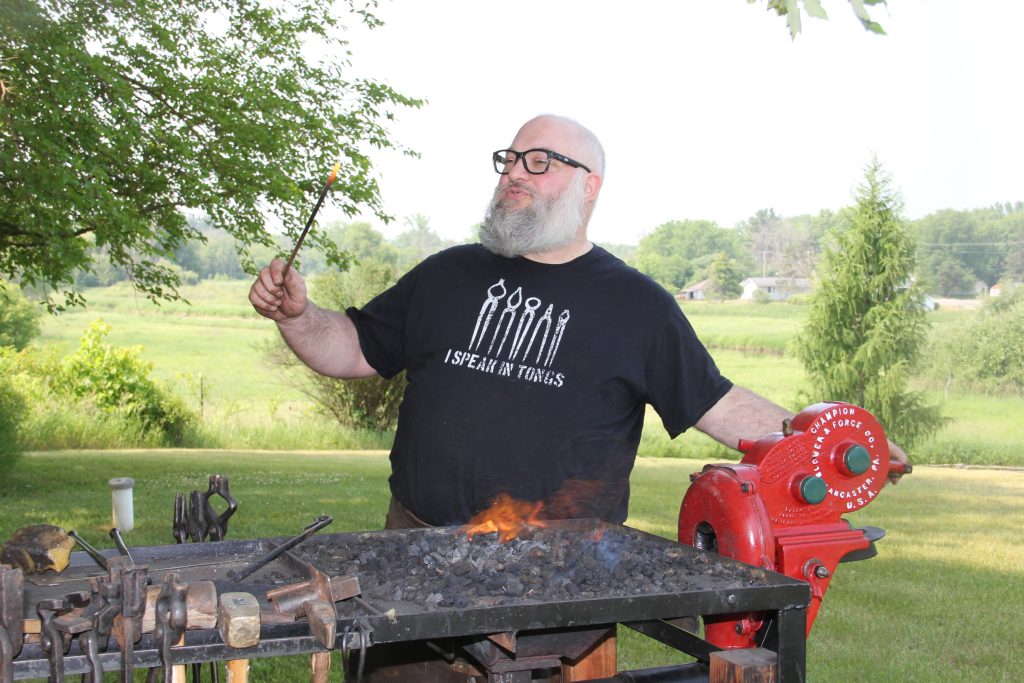
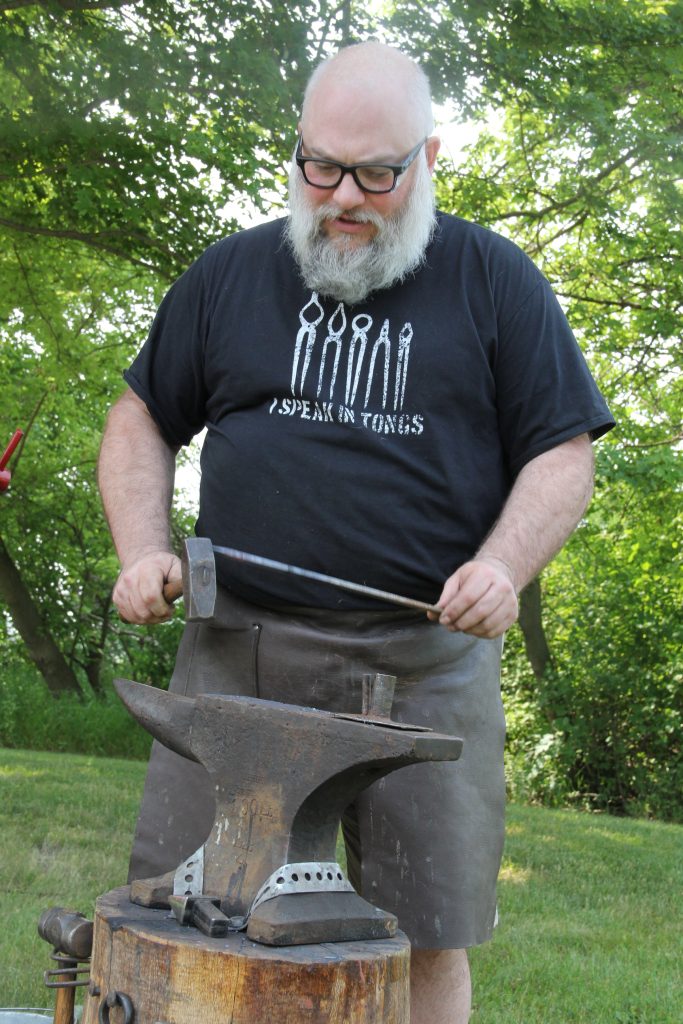
Three photos above: Nick Hamele, of Burr Oak Forge, Fort Atkinson, demonstrates his craft: blacksmithing.
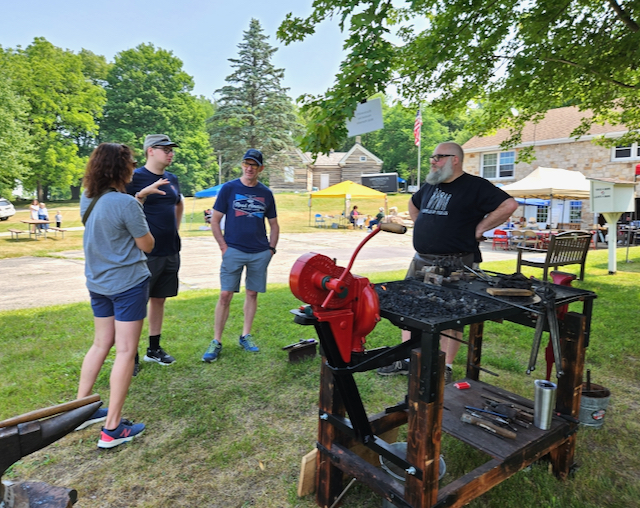
Nick Hamele, of Burr Oak Forge, Fort Atkinson, at right, talks about blacksmithing with visitors to June’s “Hands on History.” The event was held at the Fort Winnebago Surgeons Quarters in Portage.
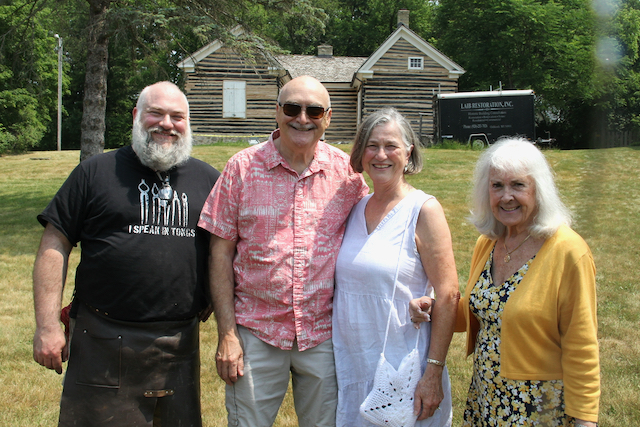
Blacksmith Nick Hamele, Fort Atkinson, from left, his parents, Eugene Hamele Jr. and Peggy Gay Hamele, Fort Atkinson, and his aunt, Helen Hamele Hintz, of Plantation, Fla., gather near the Fort Winnebago Surgeons Quarters, Portage.
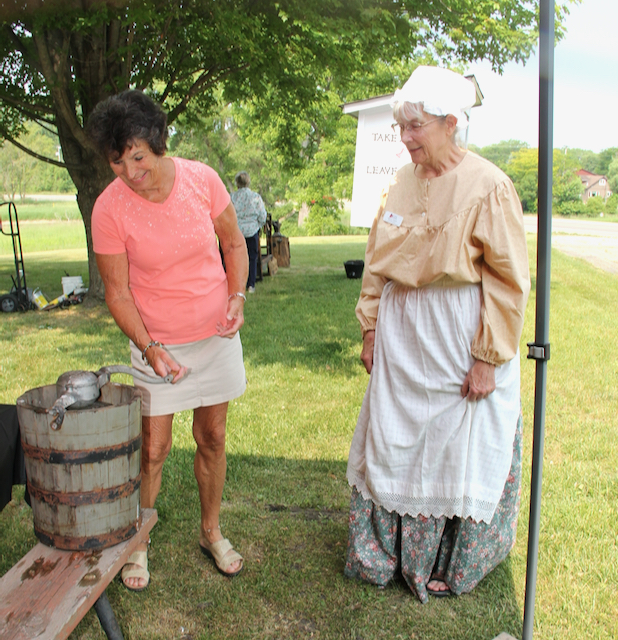
Fort Atkinson resident Nancy Olson, who also is a regent of the Fort Atkinson-Eli Pierce Chapter of the Daughters of the American Revolution, at right, demonstrates how ice cream was made in the 19th century during a recent historical event titled: “Hands on History.”
Chris Spangler photos.
This post has already been read 4932 times!
Oh my goodness! That wonderful article brought back a flood of memories. My father owned his welding/blacksmithing business in Whitewater. As I read the article, I could relive the sights, sounds, smells, and atmosphere of the times I spent at my dad’s shop. Thank you for the trip down memory lane.
Just read the article regarding teacher and forge artist,Nick Hamele. Very informative and interesting.I could have talked to journalist all day. Love our family and history.Mom was a member of DAR and can trace her family (Seaton) coming to America in the early 1600’s
. Granted 2 tracts of land on the Potomac River,called Fragility and Strife. We helped build this new nation.